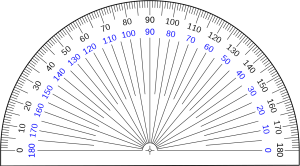
When teaching online, I was on a constant search for interactive websites to use with my students. This became even more important as I was working with my grade 6 students on measuring angles with a protractor. In the classroom, it is easy to walk around and see how students are holding and lining up the protractor, but this is obviously more challenging over Zoom. First, many of many students did not bring home their geometry sets as they were collecting locker supplies before we went online. Second, even if they had, I would not have been able to see how they were holding and using those physical protractors, even with screen sharing options. I found a few good activities on Desmos (this one and this one), but I was looking for additional practice. I then came across this selection of activities from Transum. This first one is from their Starter of the Day selection and involves estimating and then checking. This second one offers more questions of varying types of angles. Using these activities allowed me to model by sharing my screen, and then have students share their screens so I could watch how they were manipulating the online protractor and lining it up with the angle. There are many interactive activities on Transum’s website. I haven’t even begun to explore all of their offerings, but I plan to do so this summer.

